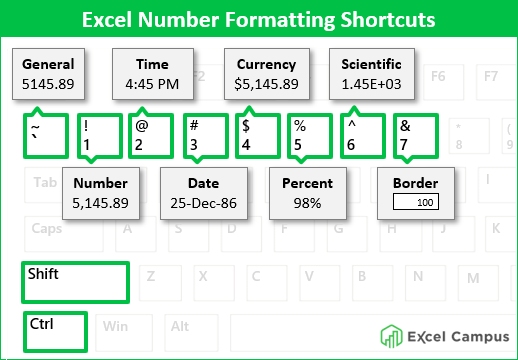
In this article, we've provided a list of commonly-used Excel shortcuts that can be used on a Mac. Using keyboard shortcuts can help you work more quickly and efficiently in Microsoft Excel, but you might face a bit of a learning curve if you're just getting started. NOTE: This shortcut will return an error if the selected column doesn't contain numeric values. To insert a =SUM() formula into a cell so that the current cell adds up all the numeric values in a column, just press the ⌘+shift+T key combination. This shortcut can be useful to understand how a sheet functions and calculates relative values for its respective cells. If you press control and the ` grave accent mark key, you can toggle the contents of your cells between values and the formulas that render the values. If you'd like to bring up the window for inserting formulas, just hold down the control and option keys while also pressing the down arrow key. To paste the contents of your clipboard with a special format such as Unicode or formula values, simply press control+option+V.

If you'd like to strip all formatting from your clipboard before pasting its contents into a cell, you'll have to press control+U to edit the cell contents. In most macOS applications, the paste shortcut is ⌘+V, and Excel is no different. On a Mac, you can press ⌘+shift+X (or CTRL+5 in Windows) to strikethrough a cell or range of cells in an Excel spreadsheet. On a Mac, however, you'll need to press ⌘ and T together to accomplish this while editing a cell. Excel inserts the $ symbol before the columns and rows for a referenced cell or range. In Windows, you can press F4 to change a cell's default reference from relative to absolute. To do this, you'll need to make sure to select the entire row first, or else it will simply shift the current cell or column down. You can also use the shortcut shown above to insert an entire row.

To delete, or shift, a row up, you can press control+- or ⌘+U on a Mac. HINT: You can also hold down the option ( ⌥) key and navigate to different sheets in your workbook by pressing the arrow keys. Press the fn+shift+F11 keys simultaneously to create a new sheet for your workbook on a Mac. Keep in mind that these shortcuts were tested on the 2016 version of Microsoft Excel. This section will cover some of the most useful Excel keyboard shortcuts for a Mac. The following table contains some useful Excel keyboard shortcuts for macOS: Functionality These shortcuts can help you boost your productivity while working in Excel. In this section, we'll show a few of the most commonly-used macOS keyboard shortcuts.
Shortcut for find and replace in excel on mac mac#
NOTE: Many basic Windows shortcuts, like CTRL+V for paste or CTRL+O to open a worksheet, can be executed on a Mac by pressing ⌘ ("command") instead of CTRL. Some of the basic keyboard shortcuts for Excel are the same on a Mac or PC, but most shortcuts, especially the more complex ones, are mapped differently for Excel on macOS. In this article, we'll review the most useful Mac Excel shortcuts, organized into a simple table for quick reference.


That's where a handy "cheat sheet" can be a game changer. While these shortcuts make many tasks easier, it can take time to learn and master them all. If you use Excel frequently, you know how much time keyboard shortcuts can save.


 0 kommentar(er)
0 kommentar(er)
